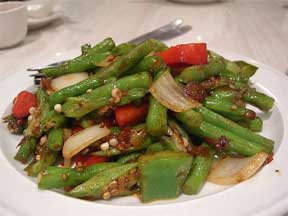A few seasons ago a folksong in the vernacular of Louisiana’s Cajun element was recorded by some of the country’s most successful vocalists. Nobody was much concerned that the words made sense to few people outside the deep South. Jambalaya is a favorite Cajun dish of meat and vegetables, but gumbo, a similar mixture also mentioned in the song is just as popular. It may be made up of almost any available meat; crabs, shrimp, ham, chicken, beef or sausage with “gumbo” or okra for flavoring, and to give the stew a more substantial consistency.
So common in parts of the South that it figures in colloquial speech, okra or “gumbo” is entirely unfamiliar in most of the northern states. Certainly it is a vegetable both deserving of wider use and adaptable to it. Okra is a tropical herb originating in Africa and a member of the hibiscus family. It is related to cotton and a likeness in foliage and bloom is easily noted. Though not so showy as the Hawaiian hibiscus, the red-centered yellow flowers of okra would alone make it worth a planting, and fully ripened stalks and pods are valuable material for dried arrangements.

Okra likes well drained, good garden soil in full sunlight. Seeds tend to rot where soil is too wet. Planting in an area known to be clean and pest free is the best way to avoid trouble with powdery mildew and a fusarium which may cause wilting and death. However, okra will tolerate quite a bit of adversity as to fertility, bearing some crop even in poor soil. It is resistant to insect pests, only occasionally being bothered by spinach aphid or corn ear worm. Both can be eliminated by insecticides which are recommended for use in the vegetable garden.
Warm Weather Crop
Okra grows only after the really warm days of late spring and early summer arrive and slows up any time cool weather comes. Among southerners there was a name for still, baking hot days. It is “cotton weather” and that is the kind of day okra likes too. Where the warm season is short, it can be planted a month early in flower pots and transplanted.
Outdoors, seeds should be sown an inch deep in rows 24 to 36 inches apart with some 30 inches allowed for each stalk’s growth. About half that space should be left if a dwarf form is used. It is ideal for the small garden where its two to two and a half feet height is preferred to the four feet strains which may reach where conditions are good. The chief advantage of planting the taller growing varieties is in their value as sun and wind protection for more tender vegetables. The shielding effect is greater where plants are not thinned too much, but allowed to stand quite close.
Well tended plants of all varieties bear heavily and just a short row or two will supply the average family.
Use It Young
Only young, tender pods should be used. Pods grow near stalk and branch tips and point upward rather than being pendant like beans. They can be gathered by a snapping off motion or cut off, washed and added whole to soups and stews or chopped as in the chicken gumbos available in complete lines of canned soups.
A favorite side dish of Texas okra growers is made by simmering okra and tomatoes together with butter and salt for 15 to 20 minutes. Possibly the very choicest way Texans cook okra, however, is frying. The pods are sliced horizontally into little round pieces not more than three-fourths inch thick, rolled in meal, salted and fried like potatoes except that okra browns more quickly and must be stirred more often.
Pods of okra laid on top of beans or black eyed peas in the kettle to steam until tender add a tasty variation. For uses such as this, where no thickening is needed, cooks usually prefer not to trim off the pod ends until serving time.
Versatile, easy to grow okra belongs in your garden this summer, and on your menu any time.
